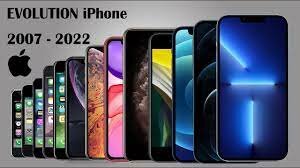Apple’s iPhone is undoubtedly one of the most popular and widely used smartphones globally. Since the release of the first iPhone model in 2007, the company has introduced several models with new and improved features. Each new model represents a significant leap in technology, design, and functionality, making it exciting for iPhone enthusiasts to look forward to new releases.
Let’s explore the evolution of iPhones from the first model to the latest version.
First iPhone Model (2007)
The first iPhone model revolutionized the smartphone industry with its unique design, multi-touch interface, and internet browsing capabilities. It featured a 3.5-inch display, a 2-megapixel camera, and 4GB, 8GB, or 16GB storage options. The first model didn’t have 3G support, and users could only connect to the internet using Wi-Fi or EDGE.
iPhone 3G (2008)
In 2008, Apple introduced the iPhone 3G, which supported faster 3G data speeds, GPS, and the App Store. The iPhone 3G also came with a slimmer design, curved edges, and a plastic back. It featured a 3.5-inch display, a 2-megapixel camera, and 8GB or 16GB storage options.
iPhone 3GS (2009)
The iPhone 3GS was introduced in 2009 and featured a faster processor, improved camera, and the ability to shoot video. It had a 3.5-inch display, a 3-megapixel camera, and 8GB, 16GB, or 32GB storage options.
iPhone 4 (2010)
The iPhone 4 was released in 2010 and featured a new design with a glass front and back and a stainless-steel frame. It had a 3.5-inch Retina display, a 5-megapixel camera, and a front-facing camera for FaceTime calls. The iPhone 4 was also the first model to support iOS 4, which allowed for multitasking and introduced iBooks.
iPhone 4S (2011)
The iPhone 4S was released in 2011 and introduced Siri, a voice-activated personal assistant. It featured a faster processor, improved camera, and a larger storage capacity of 16GB, 32GB, or 64GB. The iPhone 4S had the same design as the iPhone 4, but it was available in black or white.
iPhone 5 (2012)
The iPhone 5 was introduced in 2012 and featured a larger 4-inch display and a thinner and lighter design. It also had a faster processor, improved camera, and support for LTE networks. The iPhone 5 was available in black or white and had 16GB, 32GB, or 64GB storage options.
iPhone 5C (2013)
In 2013, Apple introduced the iPhone 5C, which featured a plastic back and was available in five different colors. It had the same 4-inch display as the iPhone 5, a faster processor, and an improved front-facing camera. The iPhone 5C had 8GB, 16GB, or 32GB storage options.
iPhone 5S (2013)
The iPhone 5S was also released in 2013 and featured a new Touch ID fingerprint sensor, which allowed for secure authentication and purchasing. It had the same 4-inch display as the iPhone 5 and a faster processor. The iPhone 5S was available in gold, silver, or space gray and had 16GB, 32GB, or 64GB storage options.
iPhone 6 And 6 Plus (2014/2015)
The iPhone 6 and 6 Plus were released in 2014 and marked a significant redesign of the iPhone lineup. They featured larger screens and a slimmer, more streamlined design compared to their predecessors. While these phones were popular at the time of their release, they are now outdated and no longer receive software updates from Apple.
In 2015, Apple released the iPhone 6S and 6S Plus, which featured improved hardware and a new 3D Touch feature. These phones were also the first to introduce the Rose Gold color option.
iPhone 7 and 7 Plus (2016)
The iPhone 7 and 7 Plus were released in 2016, featuring water and dust resistance, improved cameras, and the removal of the headphone jack. The iPhone 8 and 8 Plus followed in 2017, with wireless charging and a new glass design.
iPhone X Series (2018)
In 2017, Apple also released the iPhone X, which marked a significant shift in design with the removal of the home button and introduction of facial recognition technology. This phone also featured a larger screen with minimal bezels and an OLED display.
The iPhone XR, XS, and XS Max were released in 2018, with the XR featuring a lower price point and colorful options, and the XS and XS Max featuring improved cameras and faster processors.
iPhone 11 Series (2011)
In 2019, Apple released the iPhone 11, 11 Pro, and 11 Pro Max. These phones featured improved cameras, longer battery life, and the introduction of Night Mode for low-light photography.
iPhone 12 (2020)
The iPhone 12 lineup was released in 2020 and marked another significant design shift with a flat-edged design reminiscent of the iPhone 4. These phones also featured 5G connectivity and improved cameras.
iPhone (2021)
Finally, the iPhone 13 lineup was released in 2021, with improved cameras, longer battery life, and the introduction of Cinematic mode for video recording. The Pro models also feature a ProMotion display with a 120Hz refresh rate.
Overall, the evolution of the iPhone lineup has seen significant changes in design, features, and technology. While the iPhone 6 and 6 Plus were groundbreaking at the time of their release, the latest models offer significantly improved performance, capabilities, and user experiences.

